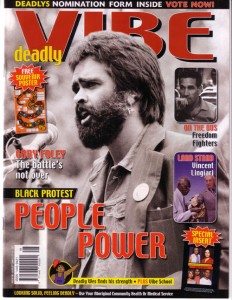Every Friday we’ll be posting a story from the huge back catalogue of Deadly Vibe magazine.
This People Power story is from August 2004 edition.
Activist Gary Foley was the man behind some of the most significant protests in Australian history. Today, he says, the fight still goes on.
Aboriginal youth on the move
Many of us have seen those powerful black-and-white images of protests in the 1960s and 70s. The pictures show passionate young men and women, marching in unison, holding flags and banners aloft while raising their fists and shouting slogans. The images take us back to an age when the Indigenous youth of Australia were well and truly ‘on the move’.
Alongside other legendary names such as Charles Perkins and Chicka Dixon, was Gary Foley, a man whose voice, pride and passion came to symbolise those turbulent days of Indigenous activism. He was a champion of the Aboriginal black power movement, and remains one of Indigenous Australia’s most beloved heroes.
Born near Grafton in 1950, Gary moved to Sydney when he was 17. “When I was 17, the Redfern police gave me quite a good kicking,” says Gary, when asked what sparked his activism. “Then a week later I picked up the autobiography of Malcolm X, whose politics had a great impact on me.”
Around this time the winds of change were sweeping the nation as significant numbers of young, politically astute Indigenous people were gathering and uniting in the demand for change, particularly in communities such as Redfern, Fitzroy and South Brisbane. From this moment on, Gary organised some of the most significant protests in Australian history, including the 1971 Springbok tour demonstrations, the Aboriginal Tent Embassy in 1972, the Commonwealth Games protests in 1982 and the Bicentenary protests of 1988.
Most significant action
“They all stay strong in my mind,” says Gary. “But it’s the tent embassy that holds a special place when I look back on it all, and that’s because its establishment remains the most significant action taken by Aboriginal people in 200 years of occupation.”
Gary was also instrumental in the founding of the Aboriginal Legal Service in Sydney and the Aboriginal Medical Service in Melbourne. He has been the director of the Aboriginal Health Service and Aboriginal Arts Board, a senior college lecturer and a consultant for the Royal Commission into Black Deaths in Custody.
And while the turbulent days of the ‘60s and ‘70s took the Indigenous cause forward in leaps and bounds, disappointingly many of the advances have since been diminished.
“In the last 20 years we have seen the emergence of a new style of Aboriginal political leadership,” Gary says. “And I would put it to everybody that the last 20 years of conservative representation has provided no gain. In fact, we have fewer land rights today then what were outlined in the Northern Territory Land Act of 1972. People need to realise that the movements that bring about change are those that challenge governments.”
Gary says the same issues remain at the heart of the Indigenous struggle today.
History is the great teacher
“The important issues facing Indigenous people today are what they have always been: land rights, justice and native title,” Gary says. “When we were at the tent embassy screaming out our slogans for land rights, we were talking about freehold title, real land ownership.
“This all holds a spiritual element for Indigenous people and relates directly to our economic independence. Once you attain economic independence, you gain self-determination, and we are no closer to genuine self-determination today then we were 30 or 50 years ago.
“The main aims today for Aboriginal people must be political and they must be about self-determination. History is the great teacher. The lessons are there.”


Comments are closed.